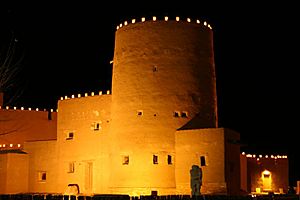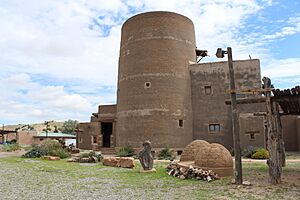Poeh Museum facts for kids
| Nah Poeh Meng | |

2005 photo
|
|
| Established | 1988 |
|---|---|
| Location | Pojoaque, New Mexico |
| Type | Native American art museum |
The Poeh Museum is in Pojoaque, New Mexico, U.S.A. Its name comes from the Tewa word poeh, which means "pathway." This museum teaches visitors about the art and culture of the Puebloan peoples. It focuses especially on the Tewa tribes in northern New Mexico.
The Pojoaque Pueblo started the museum in 1987. It is located inside the Poeh Center. The museum often changes its exhibits. It also has a large collection of permanent artifacts and special programs. The museum created an "Oral Histories Documentation" project. For this project, 38 Tewa elders shared stories about their lives. These stories are available in both Tewa and English.
Contents
Where to Find the Poeh Museum
The Poeh Museum is located off Highway 84. It is close to the Pojoaque Pueblo's Cities of Gold Casino and Hotel. The museum is about 16 miles away from Santa Fe.
History of the Museum
The Pojoaque Pueblo created the Poeh Museum in 1987. Its main goal is to share the art and culture of the Pueblo people. It covers their history from ancient times to today.
Construction on the Poeh Center, where the museum is, began in 1992. Money from gaming (casino) helped fund the building. It was finished in 2003. Other groups also helped pay for the museum's development. These included the New Mexico State Legislature and the National Endowment for the Humanities.
The Poeh Center Building
The museum is part of the Poeh Center. This center is famous for its traditional pueblo architecture. It uses building methods that have been passed down for generations. The Poeh Center also has the Poeh Arts educational program. It includes the Poeh Tower Gallery and offices. The Poeh Tower is the tallest adobe building in New Mexico.
You enter the main part of the museum through a narrow hall. It looks like a cave opening. A small water channel runs through all the exhibits. The gallery has a very good security system. It also has a special climate control system to protect the art. In 2000, Harvard University gave the Poeh Center an award. This award recognized the center's work in bringing back and sharing Pueblo culture.
Museum Collections and Exhibits
The museum has about 600 historical items. These include paintings, jewelry, pottery, textiles, and sculptures. They range from ancient times to the present day. The art is made by local people and young artists from the six Tewa-speaking tribes. This helps students in the Poeh Arts Program learn about their culture.
One exhibit shows figurines dressed in animal skins. They are in a snowy landscape with hunting tools. These figurines were made by Roxanne Swentzell, a local clay sculptor.
The Permanent Exhibit: Nah Poeh Meng
The museum's main exhibit is called Nah Poeh Meng. This means "Along the Continuous Path." It tells the story of the Pueblo people from their point of view. It shows their journey from ancient times to a modern family's living room. The exhibit includes sculptures by Roxanne Swentzell. It also features murals by Marcellus Medina of Zia Pueblo.
This permanent exhibit opened on August 14, 2005. It covers about 1,600 square feet. You can hear recorded information from local people in seven different languages. These languages are Tewa, Tiwa, Towa, Keresan, Zuni, Spanish, and English. This exhibit is special because it uses visual arts to tell the story, without any written text.
Di Wae Powa: Returning Tewa Pottery
In 2012, the Poeh Cultural Center started talking with the National Museum of the American Indian. They wanted to bring back pottery made by Tewa artists. These pots had been in the Smithsonian Institution's collection.
In 2019, 100 pots were brought to the Poeh Museum. They are now on a long-term loan. The pots came from six Tewa pueblos: Nambé, Ohkay Owingeh, Santa Clara, Pojoaque, San Ildefonso, and Tesuque. These pots had been collected by private people and museums in the mid-1800s to early 1900s. Now, these pots are on display at the Poeh Museum.
Museum Services and Programs
The museum's collections are used for teaching and research. Students can learn from them. The museum works with many other groups to support this research. These include the Southwest Association for Indian Arts and the Santa Fe Indian School.
You can also access the museum's archives and photos online. This helps with classroom learning. The online archive has information about Pueblo festivals, dances, and architecture. It also covers farming and the economy of Pojoaque. The museum has about 10,000 photographs. These range from old pictures by Edward S. Curtis to modern photos of Pueblo life. Many of these images have been organized and put online.
The museum also offers free studio space to any Native American artist. This helps local artists create new works. The museum often hosts art demonstrations and traditional dance festivals. The museum gift shop sells art and gifts unique to Pueblo culture.


